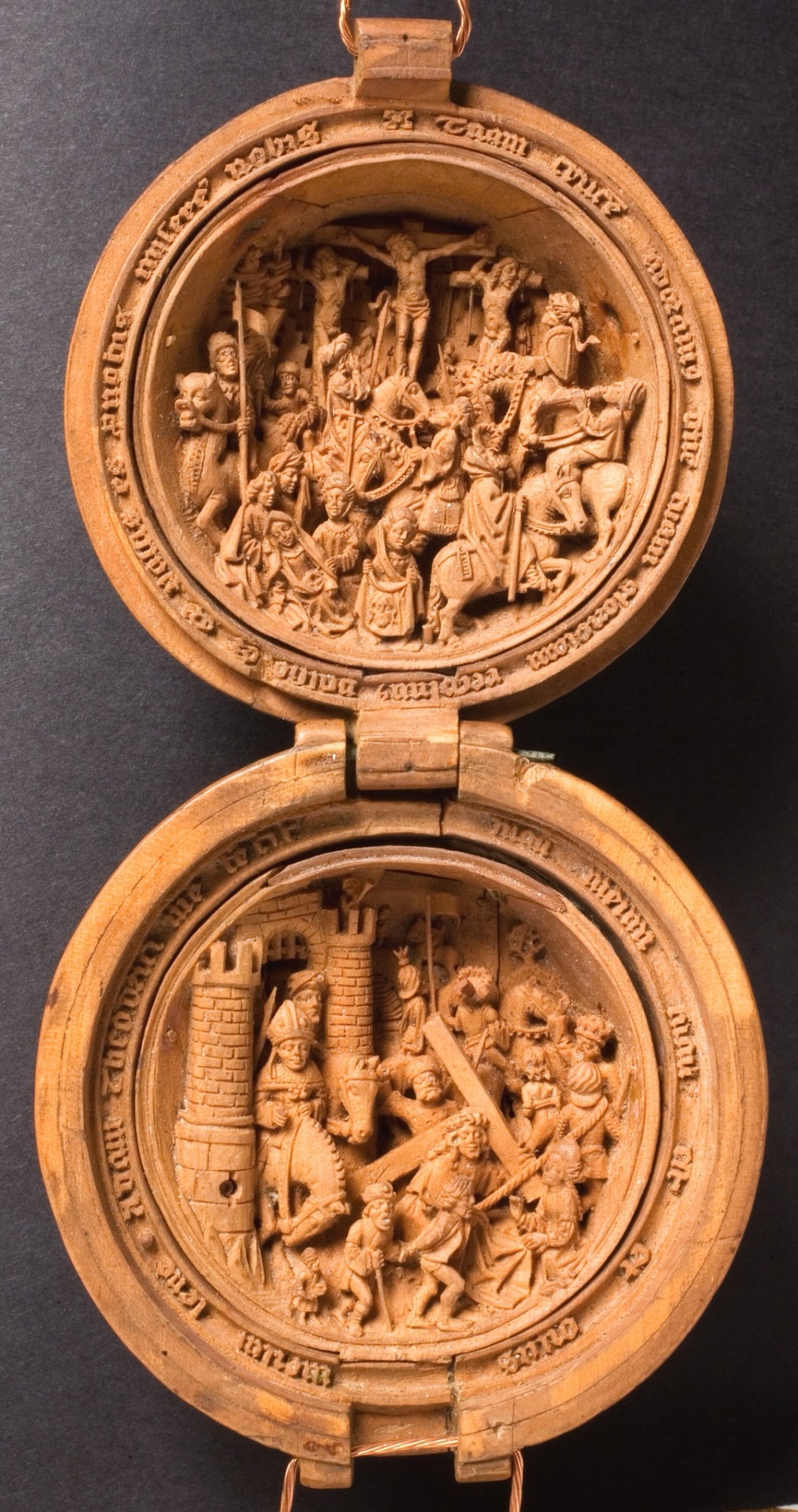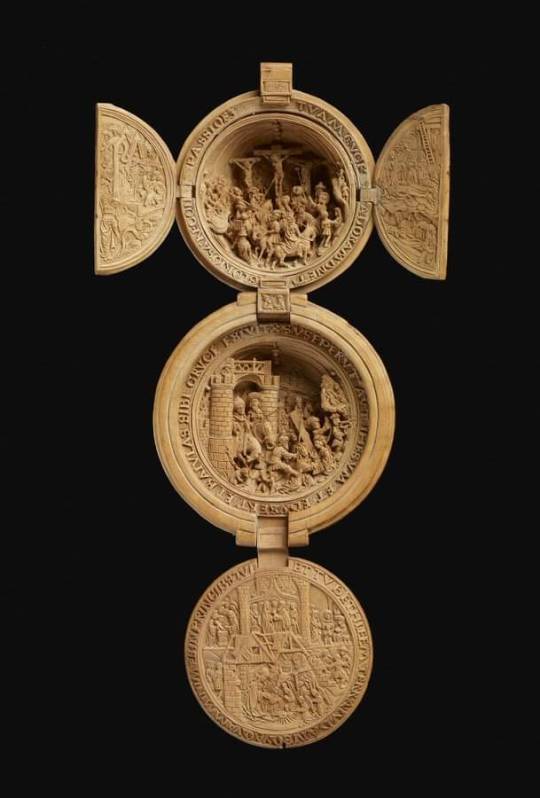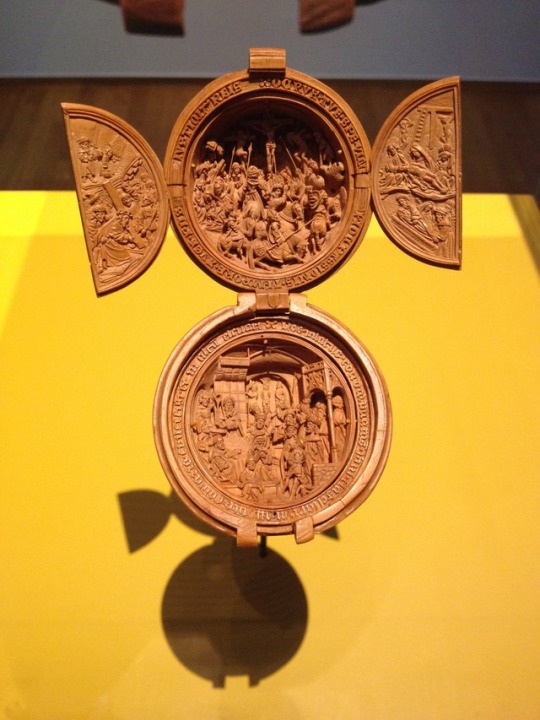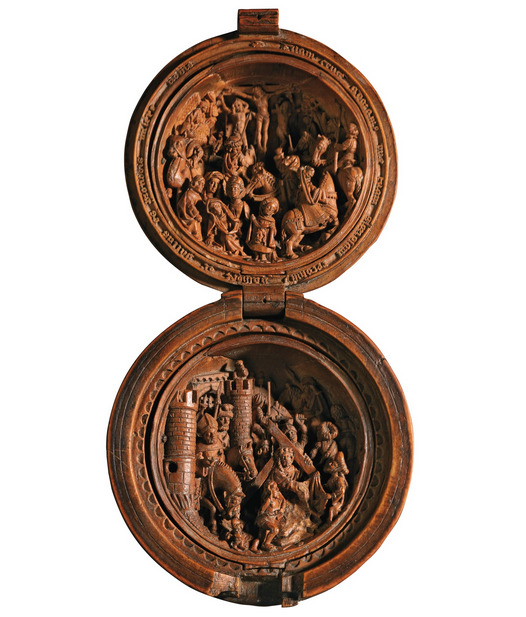#Adam Dircksz
Photo

Prayer Nut with the Nativity and the Adoration of the Magi, attributed to the workshop of Adam Dircksz
Netherlandish, c. 1500-1530
boxwood, silver, and gold
Rijksmuseum
#Merry Christmas!#Nativity#Adoration of the Magi#Christmas#Jesus#Christ Child#Adam Dircksz#Netherlandish#Northern Netherlands#art#sculpture#prayer nut#boxwood#silver#gold#religious art#Christian art#Rijksmuseum
4K notes
·
View notes
Text

Prayer bead attributed to Adam Dircksz, Dutch, ca. 1498-1501
2 notes
·
View notes
Text
This Netherlandish rosary bead was skilfully carved with astonishingly minute detail (probably created with the help of a magnifying lens) from boxwood around 1500-1525 AD, at the workshop of Adam Dircksz, possibly in Delft.
Length: 13.2 centimetres (open)
Width: 9.4 centimetres (upper doors open)
Diameter: 5.7 centimetres (upper half)
Diameter: 6.5 centimetres (lower half)
Diameter: 4.7 centimetres (upper half interior)
Diameter: 5.2 centimetres (lower half interior)
https://www.britishmuseum.org/collection/object/H_WB-235

3 notes
·
View notes
Photo



Small Wonders at the Rijksmuseum Amsterdam
First real blog post on this Tumblr! Today I’m going to talk about a small exhibition at The Rijksmuseum. The Rijksmuseum is based in Amsterdam in The Netherlands and is most known from Rembrandts painting called “The night watch”(de nachtwacht in Dutch language).
A few weeks ago I went to The Rijksmuseum to see the exhibition Small Wonders. It’s a small exhibition with these really small wooden crafts from the middle ages. These “prayer nuts” were made by Adam Dircksz who had his own studio in Delft. These micro-cravings are about the size of a walnut and people used to keep them to pray to God.
In the exhibition where a lot of these wooden nuts. They were really beautiful and still complete as you can see on the pictures. The nuts had each their own story, most of the time a religious story. I loved the fact that there were so many. They have up to 140 of these crafts and only one of them is signed with Adams signature.
You can see these wonderful prayer nuts in the from Saturday, 17 June to Sunday, 17 September 2017 in the Philips Wing of the Rijksmuseum.
Photos made by myself, information from the website and the exhibitions. Website Rijksmuseum: https://www.rijksmuseum.nl/en/small-wonders
#rijksmuseum#amsterdam#small wonders#prayer nuts#prayer#wood#woodcraft#adam dircksz#art#exhibition#exhibitions#new blog#artexhibitionblog#talking about art#art talk#walnut
2 notes
·
View notes
Photo


Miniature Triptych. Adam Dircksz and Workshop (1500-1530)
https://www.wallacecollection.org/art/collection/collection-highlights/miniature-triptych/
This miniature Gothic altarpiece shows scenes from the Old and New Testaments, with the Adoration of the Magi in the centre. It is one of the most important works from the mysterious workshop of Adam Dircksz, specialising in intricate miniature boxwood carvings. Such objects have always been a source of wonder. Intended for personal devotion, they quickly became desirable collectors' items.
12 notes
·
View notes
Photo

Prayer Nut with Scenes from the Life of St. James the Greater, Adam Dircksz, c. 1500-1530, Cleveland Museum of Art: Medieval Art
Prayer nuts or "paternosters" are generally made from boxwood and carved with extreme refinement and delicacy with openwork Gothic tracery. They came into fashion as private devotional accessories in the Netherlands in about 1500 to 1530. About 50 prayer nuts are still known to survive.
Size: Overall: 5.8 x 4.8 cm (2 5/16 x 1 7/8 in.)
Medium: boxwood
https://clevelandart.org/art/1961.87
10 notes
·
View notes
Text

▪Miniature triptych.
Maker/Artist: Adam Dircksz and workshop (active between: c. 1500-30)
Place of origin: Netherlands
Date: ca. 1500-30
Medium: Boxwood
231 notes
·
View notes
Photo

DIRCKSZ, Adam - Prayer Nut with the Road to Calvary and the Crucifixion c. early 1500's
"This small boxwood orb is decorated on the exterior with a regular network of drop-shaped recesses with quatrefoil piercings and a band of twisted branches that resemble a crown of thorns. When it is opened two intricate concave reliefs representing Christ on the road to Calvary and the Crucifixion are revealed. The two scenes, each less than 4 centimetres in diameter include no less than 27 men, 10 horses, 5 women, a bishop, a little boy, a castle and a camel.
Such orbs were designed to be worn on a rosary or belt and could be used for private devotion when its wealthy owner travelled and are therefore known as rosary beads or prayer nuts. A fragrant substance might have been inserted behind the reliefs so that with help of the openwork on the outside, the prayer nut might have doubled as a pomander. More recently, however, it has been suggested by Scholten that this particular type of early 16th-century prayer nuts was reduced to such a small scale that it probably became impractical to use (op.cit. Bulletin, pp. 337-339). Rather than being of purely religious or talismanic use they might therefore be among the virtuoso carvings commissioned for the earliest cabinets of curiosities, made to be studied and marvelled at."
© 2015 Sotheby’s
More information here:
https://www.youtube.com/watch?v=-xGYBBB7zFk
17 notes
·
View notes
Photo

Prayer Nut with Scenes from the Life of St. James the Greater, Adam Dircksz, c. 1500-1530, Cleveland Museum of Art: Medieval Art
Prayer nuts or "paternosters" are generally made from boxwood and carved with extreme refinement and delicacy with openwork Gothic tracery. They came into fashion as private devotional accessories in the Netherlands in about 1500 to 1530. About 50 prayer nuts are still known to survive.
Size: Overall: 5.8 x 4.8 cm (2 5/16 x 1 7/8 in.)
Medium: boxwood
https://clevelandart.org/art/1961.87
10 notes
·
View notes